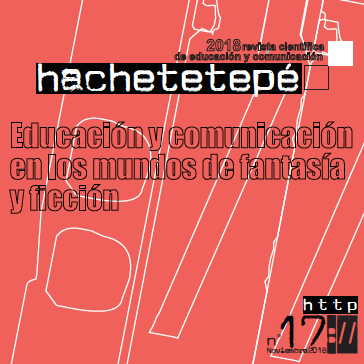Seeing different worlds stimulates the imagination
Abstract
The human being has always had the need to imagine what the future will be like and through cinema has found the best vehicle to project those ideas through scientific fiction. To unite the visible and invisible, imagination and understanding, to communicate the inexplicable, to make the abstract and recognizable look unrecognizable. Many of the predictions that science fiction has presented through the film media have become reality. The visual images of fantasy worlds and scientific fiction stimulate the spectator´s imagination, leading him to think more than even themselves can explain. That possibility of seeing further is explained by Kieran Egan in his theory on Imaginative Education in which he revalues the importance of imagination and fantasy as instruments for learning, emphasizing that imagination drives ideas and ideas solve problems.
Keywords
Downloads
How to Cite
License

This work is licensed under a Creative Commons Attribution-NonCommercial-NoDerivatives 4.0 International License.
Those authors who have published with this journal, accept the following terms:
- They will retain their copyright and guarantee the journal the right to first publication of their work, which will simultaneously be subject to the Creative Commons Attribution License . They may be copied, used, disseminated, transmitted and publicly displayed, provided that the authorship, url, and magazine are cited, and are not used for commercial purposes. No derivative works are allowed.
- They may adopt other non-exclusive license agreements for the distribution of the published version of the work (e.g., deposit it in an institutional telematic archive or publish it in a monographic volume) provided that the initial publication in this journal is indicated.
- Disseminate your work through the Internet (e.g., in institutional telematic archives or on your website) once the manuscript is accepted, which may lead to interesting exchanges and increased citations of the published work. (See The effect of open access).
Hachetetepé. Scientific journal of education and communication does not charge a fee for the submission of manuscripts or for the publication of its articles.
References
Danto, A. C. (1981). The transfiguration of the commonplace: a philosophy of art. Cambridge, Mass: Harvard University Press.
Delgado, A.; García, D. & Truneanu, V. (2006). La estética de la recepción en La Historia Interminable. Revista de Artes y Humanidades ÚNICA, 17.
Delgado, L. (2016). Eduardo Manostijeras: el inicio de un binomio creativo. Revista lúdico cultural de los lunáticos Moon magazine, Disponible en: https://www.moonmagazine.info/eduardo-manostijeras-el-inicio-de-un-binomio-creativo/
Christopher, C.; Berger, H. & Ehrsson H. (2013). Mental imagery changes multisensory perception. Current biology. Disponible en: DOI: 10.1016/j.cub.2013.06.012.
Clavel Vázquez, A. (2015). Ficción, imaginación y embodied meaning. Páginas de Filosofía, Año XVI, 19;-155.
Friend, S. (2008). Imagining Fact and Fiction. In New Waves in Aesthetics.
Kind, A. (2011).The Puzzle of Imaginative Desire. Australisian Journal of Philosophy, 89(3); 421-439.
Grande-López, V. y Pérez García, A. (2016). Personajes de animación con discapacidad a través de una perspectiva educativa. Creatividad y Sociedad (25); 259-283.
Grimaldo, A.; Judson G.; Boullosa, P. & Acuña, S. (2017). Educación imaginativa: Una aproximación a Kiera Egan. Madrid: Morata.
Egan, K. (1991). La comprensión de la realidad en la educación infantil y primaria. Madrid: Morata.
Egan, K. (1994). Fantasía e imaginación: su poder en la enseñanza. Madrid: Morata.
Egan, K., Judson G. (2018). Educación imaginativa. Herramientas cognitivas para el aula. Madrid: Narcea Ediciones.
Hanson, M. (2006). Cine digital: escenarios de Ciencia-Ficción. Barcelona: Océano.
Larios M.A. (2012). El ojo que piensa. Revista de cine iberoamericano, año 3, núm. 6.
Padalino, L. (2017). Eduardo Manostijeras, una historia sobre la aceptación. La mente es maravillosa. Disponible en: https://lamenteesmaravillosa.com/eduardo-manostijeras-una-historia-sobre-la-aceptacion/
Pérez Agusti, A. (2003). 75 años de Cine de Ciencia-Ficción. Madrid: Masters.
Pérez Mora, E. (2005). La historia interminable en el cine... y debe ser contada en otra ocasión. CLIJ Cuadernos de literatura infantil y juvenil, 180.
Rodríguez G. (2013). Imaginación y conocimiento. Técnica industrial. Disponible en: http://www.tecnicaindustrial.es/TIFrontal/a-5461-imaginacion-conocimiento.aspx.
Sánchez Quevedo, J. I. (2016). Poéticas del entretenimiento: imagen, movimiento y narración en el cine de Steven Spielberg. Tesis doctoral. Madrid.
Ward, P. (2003). Picture composition for film and television. Burlington: Focal Press. Burlington.






